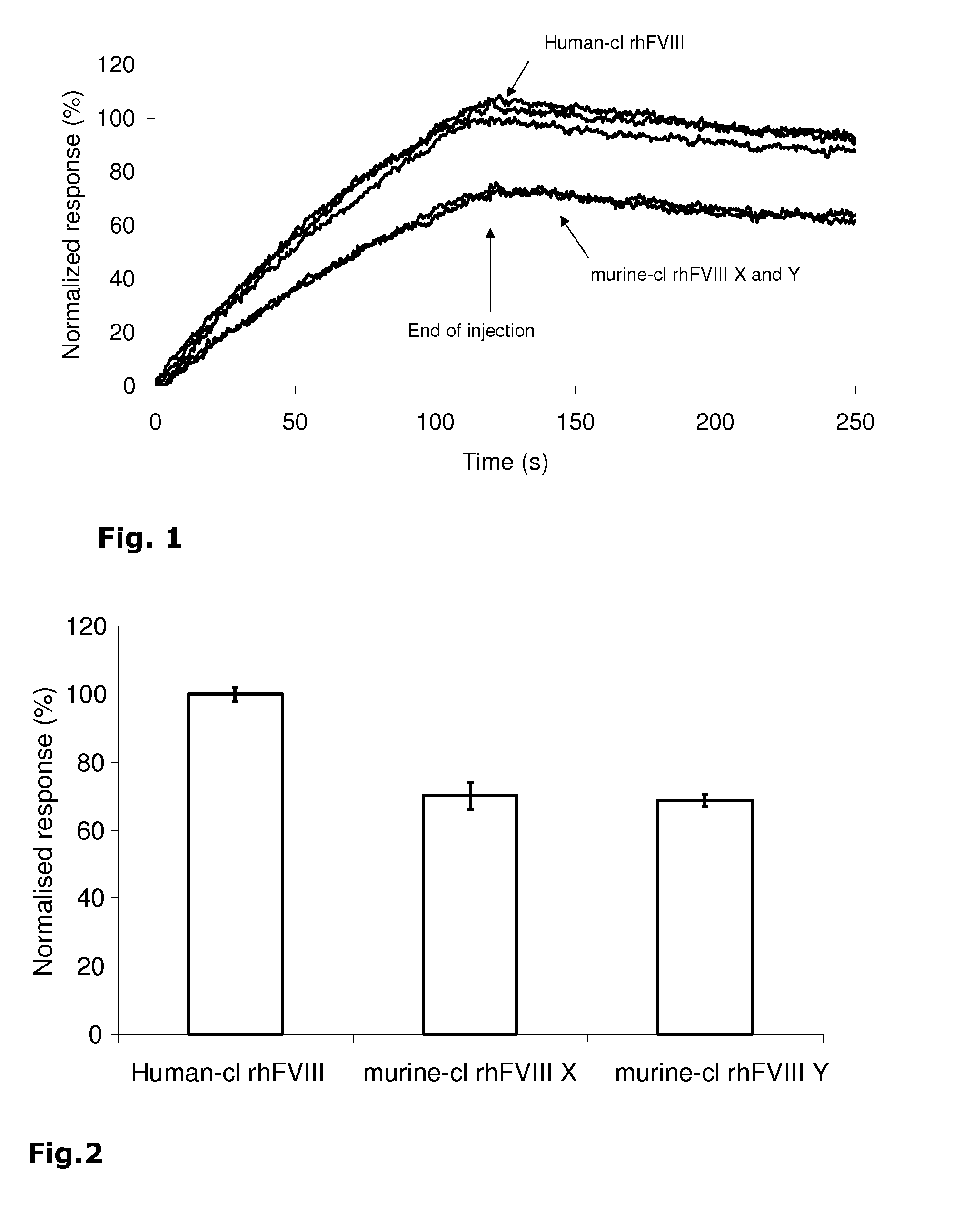Recombinantly produced human factor viii and ix
a technology of human factor viii and glycoprotein, which is applied in the direction of enzyme stabilisation, peptide/protein ingredients, extracellular fluid disorder, etc., can solve the problems of plasma-derived inhibitors, high inhibitor formation rate, and impaired therapeutic effect, so as to improve the functional properties, improve the binding effect, and improve the effect of beneficial effect of protein
- Summary
- Abstract
- Description
- Claims
- Application Information
AI Technical Summary
Benefits of technology
Problems solved by technology
Method used
Image
Examples
example 1
[0049]A human B-domain-deleted factor VIII protein, human cell line recombinant human factor VIII (human-cl rhFVIII), was produced in the human cell line HEK293F according to the process described in EP-A-1 739 179 (Schröder et al., 2007b; Schröder et al., 2007a). The purification process consisted of five chromatography steps and generated a highly pure factor VIII protein (Winge et al., 2008).
[0050]The sialic acids of purified factor VIII protein (400-600 μg) of which 10 μg of Ketodeoxynonulosonic acid (KDN; internal standard) had been added were acid hydrolysed using 0.1 M Hydrochloric acid (80° C. for 1 hour). The products were purified using Dowex cation exchange chromatography and the resulting solution was lyophilized, resuspended in water and analysed by HPAEC-PAD. A standard mixture containing 5 μg each of Neu5Ac and NeuGc and 10 μg KDN and a reagent blank with 10 μg of KDN were hydrolysed and analysed in parallel with the samples.
[0051]Table 1 and 2 show the results from a...
example 2
[0052]The binding of human-cl rhFVIII to human von Willebrand factor was analyzed using surface plasmon resonance with the Biacore 3000 instrument. The recombinant factor VIII products X and Y derived from murine cell lines (murine-cl rhFVIII X and Y) were used as comparators.
[0053]The von Willebrand factor was immobilized through primary amines to the carboxymethylated dextran of a CM5 sensor chip. The binding data were globally fit to a simple interaction model yielding kinetic parameters and affinities. The kinetics in binding and affinity to von Willebrand factor were analyzed. Furthermore, a quantitative measure of the capacity of Human-cl rhFVIII to bind to von Willebrand factor in comparison with other recombinant factor VIII products was obtained.
[0054]Table 3 below shows the kinetic parameters and affinities obtained for human-cl rhFVIII in comparison to murine-cl rhFVIII products X and Y. It is shown that human-cl rhFVIII has a significantly higher affinity, about 50-60%, ...
PUM
| Property | Measurement | Unit |
|---|---|---|
| molecular mass | aaaaa | aaaaa |
| affinity | aaaaa | aaaaa |
| pharmaceutical composition | aaaaa | aaaaa |
Abstract
Description
Claims
Application Information
 Login to View More
Login to View More - R&D
- Intellectual Property
- Life Sciences
- Materials
- Tech Scout
- Unparalleled Data Quality
- Higher Quality Content
- 60% Fewer Hallucinations
Browse by: Latest US Patents, China's latest patents, Technical Efficacy Thesaurus, Application Domain, Technology Topic, Popular Technical Reports.
© 2025 PatSnap. All rights reserved.Legal|Privacy policy|Modern Slavery Act Transparency Statement|Sitemap|About US| Contact US: help@patsnap.com

